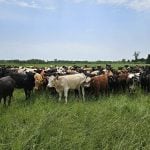Lean hog futures have lost 57 per cent of their value since prices peaked at a historical high of $134 per hundredweight on July 15, 2014.
As always, the news was incredibly bullish at the top. Expectations for higher hog prices ran rampant, as the industry was concerned about the PED virus outbreak and the possibility of lower pork production in the months ahead.
The rapid rise and fall of this market created a V-Top. Dynamic and substantial price moves often follow V-Top formations.
V-Tops contain three essential components:
Read Also

Canadian canola prices hinge on rain forecast
Canola markets took a good hit during the week ending July 11, 2025, on the thought that the Canadian crop will yield well despite dry weather.
1) Prices must be in an uptrend and a futures contract is more apt to be in a near-vertical rise.
2) A pivot point is reached which will mark the extreme high price level. While this will most commonly be a single trading session, wherein the selling pressure reaches a climax, it may in fact be composed of a few sessions of activity at or near the high price.
3) The third condition is the sudden emergence of a downtrend. An aid in recognizing this downtrend at an early stage is to compare the slope of prices during the rally to the slope of prices after the pivot. If the angle of decline is approximately equal to the angle of the advance, the pattern is more likely to be valid.
Market psychology
Since the market is likely to be in a vertical rise prior to the V-Top, the longs are reaping profits and the shorts are being battered. Suddenly, a dramatic shift in psychology drives the longs to cover (sell) their positions. They find that they have plenty of company, as potential new shorts also want in.
Emotions probably run higher in a V-Top than in any other chart formation. Without news to explain the sudden turn, longs may at first misjudge the turn as being merely a downward correction. With profits on the books, they are going to wait and see what happens, which proves to be a big mistake! The market is forced lower by aggressive new shorts and suddenly the longs are trying to make the best of a rapidly deteriorating position, as the motivation to preserve profits quickly takes hold.
Unlike other major chart formations which indicate a trend reversal, a V-Top takes little time to form, so this pattern is difficult to predict. However, on July 18, 2014, a two-week reversal materialized on the weekly nearby chart. This is a reversal pattern which often appears at the height of a sustained bull market rally and identifies a vast change in market sentiment, a clue this could be a major top.
A two-week reversal occurs when a market advances to a new high and closes near the high of the week. The following week, prices open unchanged to slightly higher, but selling picks up early in the week causing the advance to halt and prices begin to erode. By the end of the week, the market drops to around the preceding week’s low and closes at or near that level. The longs respond to weakening prices by exiting the market. This is referred to as long liquidation and is the reason a bull market dies under its own weight.
Hog producers who were able to recognize this reversal pattern locked in prices at the top of the market, just before the CME lean hog futures plummeted $76 per hundredweight. Fortunately for hog producers in Canada, the weak Canadian dollar has helped to offset some of the effect of falling hog prices.
This is a classic example of how charting and technical analysis can help producers recognize market tops, so they can lock in prices (hedge), just before a market turns down.
Send your questions or comments about this article and chart to [email protected].



















